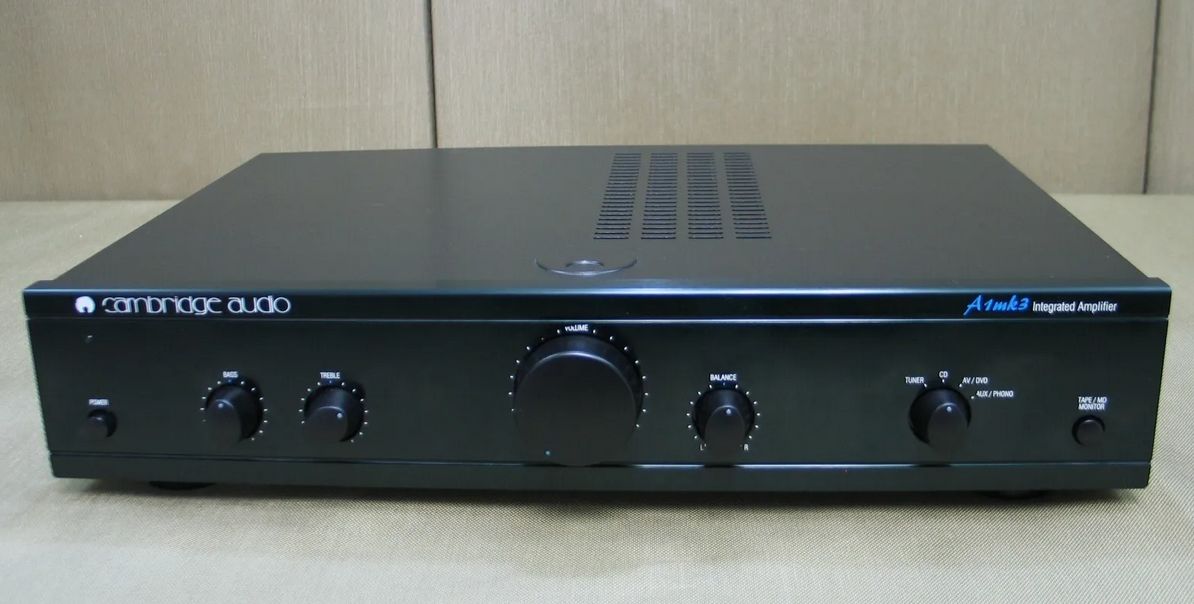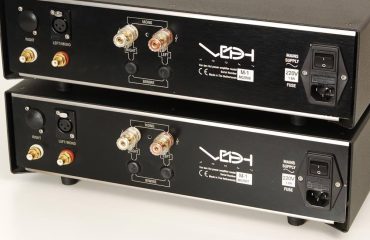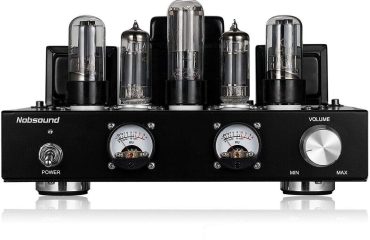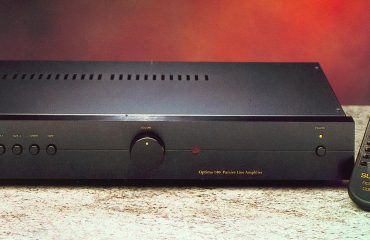Does this company know how to built musical gear for next to no money? It has proved it before.
It is often mentioned to us that we have a tendency to wax poetic about equipment most people would need half a century to save up for. In actual fact we are delighted when we can recommend an inexpensive component that reproduces music so that it still sounds like music. That doesn’t happen, perhaps, as often as you would like. Nor as often as we would like either.
Oh, we’ve tested inexpensive amplifiers before. Take the Arcam Alpha II, reviewed some years back in UHF No. 28…please. One of our panellists actually walked out before the session was over! Could Cambridge do better?
The A1 is styled to match the CD4 player, which we reviewed with considerable enthusiasm in UHF No. 48. It is attractive, if not actually striking. Its front panel includes a headphone jack and bass and treble controls, all of which we have reservations about. Tone controls can’t correct errors accurately, but they generate distortion while they try. And the headphone jack inevitably includes a switch to cut off the speakers when you insert the phone plug into the jack. That switch is in the output circuit all the time, of course, even if you don’t own headphones. But amplifiers of this price are not aimed at purists. Less experienced buyers see the phone jack and the extra knobs, and they figure they’re getting more for their money.
Naturally, the jacks on the rear panel (for four high-level inputs plus the tape loop) are the least expensive available, and no extra money has been spent on an external fuse holder. The binding posts are not exactly impressive, but they are way better than the “guillotine” terminals usually found on amplifiers and receivers in this price range. They are tapered, not hexagonal, so you have to hand-tighten them. The final cost-cutter: a label that says “Built under license in PRC.” You don’t need a degree in geography to identify the initials as standing for the People’s Republic of China.
We opened the session with a decidedly tough piece: A Chorus Line from Frederick Fennell’s Beachcomber disc. There’s a lot happening at once on this disc, and an inadequate amplifier (which takes in a lot of ground even in higher price ranges) will render much of it unrecognizable. Did that happen with the A1? Not to keep you in suspense, no!
Indeed, what we heard was so good we were left shaking our heads. The music was altered, but it remained enjoyable and, most important, it remained music. The bright and brash brass instruments, which have a quorum on this disc, had hardened somewhat, but they didn’t turn into an indistinct blur. Even the percussion solo was impressive, despite the reduced authority of the entire bottom end. We were doubly surprised because this is not a muscle amp — its 30 watt/channel rating places it in a modest category. Depth and image were less convincing than with our reference, naturally, but no essential element of this difficult recording got hopelessly messed up.
We were similarly impressed with West End Blues from the Opus 3 20th anniversary sampler (CD19692). The opening cornet solo, fuelled by the extra detail of HDCD, was gorgeous, its timbre virtually intact, its presence striking. We were struck once again by the fine details this amplifier was able to dig out. The bottom end was a little light, once again, and that affected the banjo, which establishes the strong rhythm in the second part of the piece. “For this piece to work,” commented Reine, “it has to be lyrical and it has to swing. And it does.”
There was lots to like in Chill on Cold, by the great blues singer and guitarist Doug McLeod (AudioQuest AQHD1041). The words were clear, the voice plausible. Though the bass and the percussion were lighter, the rhythm came through well, and it caught us up. Detail was once again very good, though Reine complained of a lack of richness in McLeod’s very important guitar solo.
We had a feeling that the A1 wouldn’t do so well with our choral recording, Now the Green Blade Riseth (Proprius PRCD9093), because massed voices are so tough to reproduce, and this recording has important solo instruments plus its legendary depth. The Cambridge surprised us once more, digging out enough fine detail to render all of those voices plausibly. The individual instruments, including the double bass at the low end and the flute at the other extreme, came through well. The choir itself was mostly fine, despite a certain emphasis of the sibilants, and a definite hardness in the very loud parts.
So far, we hadn’t run across any passages that were even close to unlistenable. Nor would we. That’s important, because we firmly believe that your equipment should not dictate what recordings you can listen to.
We ended the session with that delicious but so fragile piece, the Arensky Piano Trio No. 1 (Dorian DOR-90146). It worked well, with enough detail to allow it its usual character — moving and emotional. Even the near silences were delicious, Gerard noted. To be sure, everything was somewhat lighter, with less authority, and Reine found the rhythm somewhat draggy.
We had played the trio at the same volume as with our reference amplifier and preamplifier. Would things improve if we played it louder? They did. The extra volume did not add hardness to the instruments (though it certainly would have if we had turned it up some more), but it brought forth extra detail even at the bottom end. It also magnified the inevitable faults, of course, but those faults at no time dominated.
We took the amplifier into the lab for our usual technical tests. The A1 more than met its 30 watt power rating, both channels driven, at 20 kHz, a frequency at which some amplifiers begin to poop out. Oddly, it didn’t do as well — nor did it quite meet its own specifications — at other frequencies. At 1 kHz and 20 Hz, it clipped at 26.3 watts and 27.4 watts respectively. We found no low-level shenanigans, aside from a higher than usual noise level, most of it hiss.
Crosstalk between adjacent inputs was commendably low: a very low -67 dB at 1 kHz, and a still better than average -49 dB at 10 kHz. Leakage within the tape loop was about 3 dB worse.
We should, perhaps, place our enthusiastic comments in perspective by adding that our amazement at the A1’s performance was very much based on its price. We would have been lukewarm on the A1 if it had cost, say, $1480. But at a full thousand dollars less than that, it is a phenomenon.
What is even more amazing is that it is being offered, in Canada, as part of a starter system that is offered for $1350, which is of course less than most of the other amplifiers reviewed in this issue. How good is it? In the print version of UHF, you just turn the page. On line, well…
- Model: Cambridge A1
- Price (in Canada): used to be $480 but you can get it for much less in 2024 on eBay
- Dimensions: 43 x 31 x 9 cm
- Warranty: 3 years, transferable
- Most liked: Good where it really matters
- Least liked: Light on muscle
- Verdict: For economy systems, the one to buy
Now let’s be quite clear on this. It is not a giant killer, but it will put to shame quite a few average units. It doesn’t have the bloom, the dynamic range or the authority of the reference. It doesn’t dig as deep or carve holographic images in space with a life of their own. But it’s nice to listen to.
Everything appeared lighter than with the reference, and rhythms were not as pronounced but instruments timbre was quite acceptable. The texture was preserved, and voices were very good too — never hard or irritating but smooth and expressive.
Don’t look for deep bass here (but then maybe you should try biamplifying with two of their power amps — I hear they’re affordable too). You won’t be disappointed with details, though. I couldn’t get over how much there was in the mids and the highs.
And besides, everything was definitely improved when we listened again at higher volume. With this amp you’ll be able to afford more CD’s and you’ll have music too. Imagine that!
–Albert Simon
I have to admit to being mightily surprised by the A1. I’ve heard plenty of economy amps, and they all have that nasty, grey, “transistor” sound. To make the A1 sound like that, you have to push it really hard. And if your loudspeakers are reasonably efficient, you’ll never need to.
Within its limits, it delivers real music. How many other amplifiers in this price range can make that claim? I can’t think of any right offhand…
–Gerard Rejskind
You say you’d like to own a combined amplifier and preamplifier of satisfactory quality without courting financial ruin? This Cambridge A1 is just what you’ve been looking for.
I wasn’t very happy with the first hour of the listening session, but then we listened again at higher volume, and I discovered a number of this amplifier’s qualities: good impact, plenty of detail, clear words, a lovely flute, and sound that is emotional, and lyrical. It sings. What comes out is, in a word, music.
I still can’t get over it. Look, we are talking about an amplifier costing one thirtieth the price of our reference. What do you think?
–Reine Lessard






